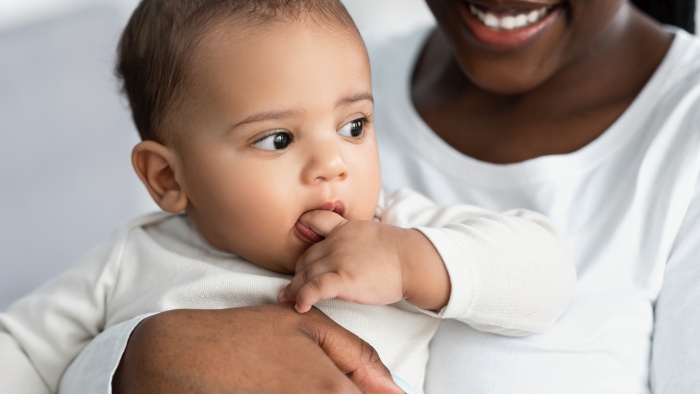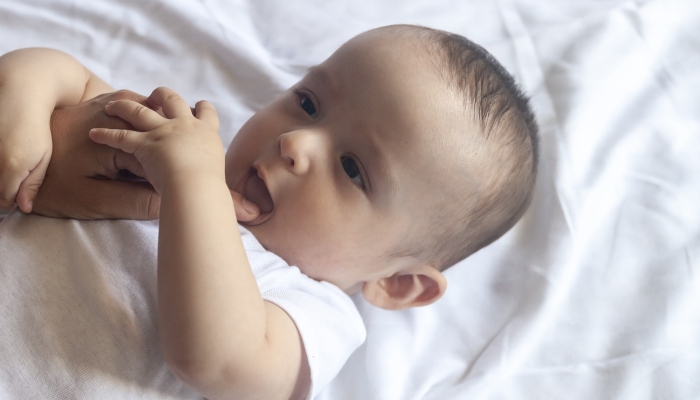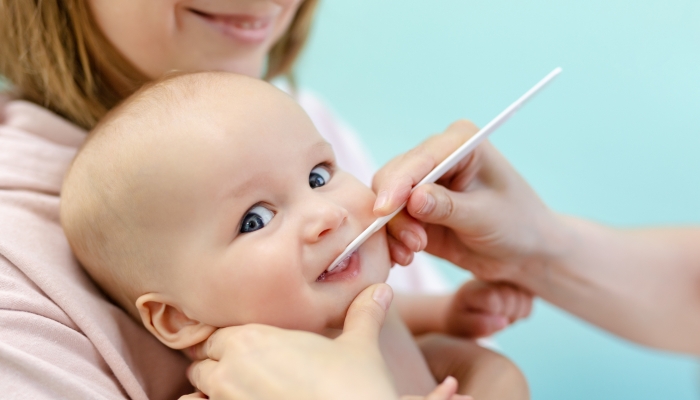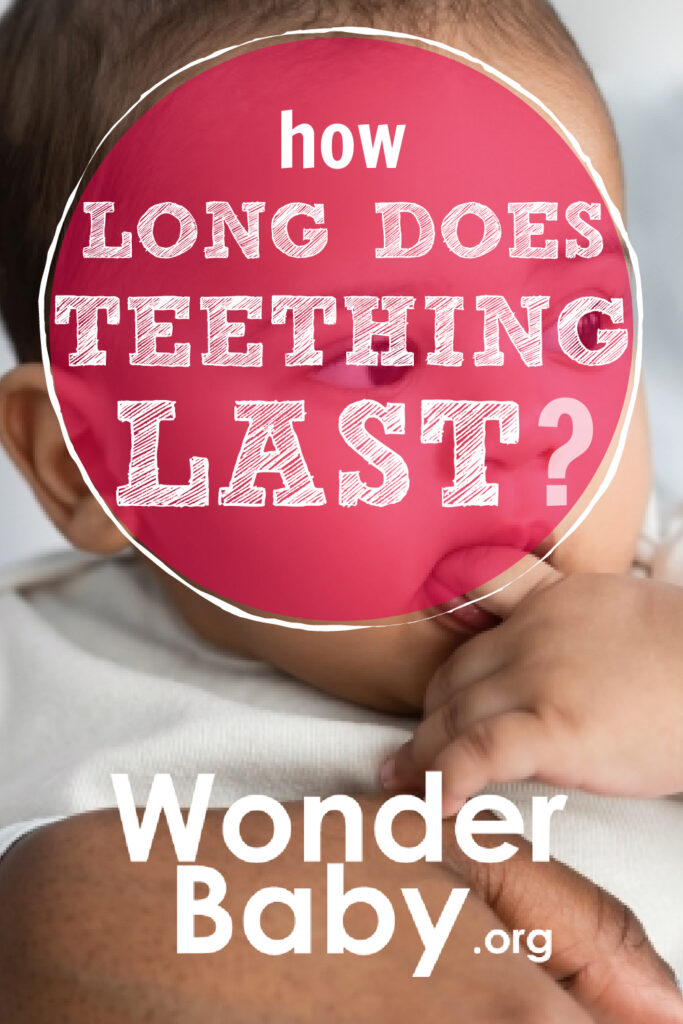How Long Does Teething Last?

- Teething can last until babies are around 25 to 33 months old.
- The average age for a baby’s first tooth to appear is around 6 months old.
- Some babies’ teeth can appear when they’re 4 months old or after they turn one.
- Babies are born with 20 teeth that cut through their gums at different times over the course of around 2 years.
One minute your baby’s giving you the cutest gummy grin, and then out of the blue, she’s drooling all over the place and running a fever. Enter your baby’s first tooth.
Teething can be such a pain.
It can be physically painful for babies (for breastfeeding moms, too! Chomp!), and it can be emotionally painful for you to watch your little one struggle.
Then again, there are babies who will show no signs of discomfort while teething. There are even some babies who are born with teeth.
Toothy grin or gummy grin – more teeth are coming! You’ll quickly realize the meaning behind “growing pains” as your baby gets her chompers.
Perhaps you won’t be able to resist wondering: How long does teething last?
Sink your teeth into everything you need to know about teething, what to expect, and tips on caring for your teething baby.
When Does Teething Start?
Most babies start teething between 6 and 10 months of age.
You’ll notice a bluish-gray bubble on the gum. Say hello to your baby’s new friend – that’s where her tooth will appear! Your baby may seem the most uncomfortable and irritable when the tooth is ready to break through her gum.
How Long Does Teething Last?
The entire teething process lasts about 25 to 33 months. New teeth sprout up in spurts so don’t worry about your baby having to endure pain the whole time.
It takes about a week for babies’ first teeth to fully grow in. Factor in a few days before the tooth appears and a few days afterward.
Baby teeth come in various shapes, sizes, and rates of growth. With that in mind, there’s a general order a baby’s teeth grow in.
According to the United Kingdom National Health Service, here is the order a baby’s teeth grow in:
- bottom incisors (bottom front teeth) – at around 6 months
- top incisors (top front teeth) – at around 6 to 8 months
- top lateral incisors (either side of the top front teeth) – at around 9 to 11 months
- bottom lateral incisors (either side of the bottom front teeth) – at around 10 to 12 months
- first molars (back teeth) – at around 12 to 16 months
- canines (between the lateral incisors and the first molars) – at around 16 to 20 months
- second molars – at around 20 to 30 months
There are some instances that baby teeth come in out of order. Factors such as thick gums and genetics come into play here. As long as your baby’s teeth come through, it’s nothing to worry about.

How to Tell That Your Baby Is Teething
With some babies, a new pair of pearly whites may come as a surprise when there aren’t any signs of teething. Many babies will definitely let you know.
Here are some signs to expect when your baby starts teething:
- A low-grade fever (between 99.6 and 100.3 F, or 37.5 and 40 C)
- Sore gums
- Flushed cheeks
- Irritability
- Ear-rubbing
- Increased drooling
- Increased hand in mouth activity
- Increased sleep disturbances
- Gnawing and chewing on hands and objects
You may also see your baby chewing on her tongue coupled with other teething signs, such as sore gums and increased drooling. Tongue-chewing is a self-soothing technique that babies employ to relieve teething pain.
To get an idea of what to expect from your baby’s teething journey, it’s helpful to become familiar with the stages of teething and common teething symptoms.
Teething Stages & Behaviors
Stage: Incisors
What you’ll see/feel: You’ll be able to feel the edges of the teeth that are right beneath the gums.
Your baby’s behaviors: She’ll chew on her hands and other objects. She’ll also be drooling a whole lot.
What to do: Provide your baby with a safe chewing toy and a bib to keep her dry and prevent rashes.
Stage: Primary Molars
What you’ll see/feel: You’ll notice teeth towards the back of the mouth.
Your baby’s behaviors: Expect even more drool, crankiness, and perhaps a low fever. She may have trouble sleeping.
What to do: Before giving your baby over-the-counter medication, always ask her pediatrician first.
Stage: Canines
What you’ll see/feel: You’ll discover teeth between the incisors and molars, on the top and bottom of her mouth.
Your baby’s behaviors: She’ll continue to drool, chew on everything, and perhaps remain irritable (especially if she’s not sleeping well).
What to do: Hang in there and continue comforting your baby.
Stage: Second Molars
What you’ll see/feel: This is when you’ll see her largest teeth emerge in the very back of the mouth.
Your baby’s behaviors: Your baby’s behaviors: This is the stage when teething hurts the most. She’ll seem inconsolable from all the discomfort she’s feeling.
What to do: Offer your child a hard vegetable, such as a frozen carrot. Monitor her the entire time she chews on it.
You may find that teething symptoms seem worse at night. At nighttime, your baby is most likely exhausted. On top of that, there are fewer distractions to compete with her teething pain.
Caring for Your Teething Baby
It’s a tough time for your baby. Fortunately, there are several things you can do to help soothe her sore and aching gums.
Give Her a Gum Massage
Use a clean finger to rub your baby’s gums. Your baby will appreciate the counter-pressure on her emerging teeth.
Give Her Something to Chew on
A silicone teething ring may be just the thing your baby needs to distract her from all this teething business. Better yet, throw the teething ring in the refrigerator to help numb her pain. Avoid freezing the ring because it may hurt and damage your baby’s gums.
A pacifier that’s made of just one piece (with no removable parts) may also help soothe your baby.
Stay clear of liquid-filled teething rings, which can break in your baby’s mouth. Make sure to also avoid tying teething rings around your baby’s neck, even if it seems more convenient for you and your baby. Tying anything around the neck poses a strangulation hazard.
Give Her Something to Eat
If your baby is eating solid food, offer her a chilled cucumber or carrot and supervise her in case she bites off a large piece.
Shower Her With Love
Give your baby your undivided attention and show her extra affection. She may seem very cranky and inconsolable, but the extra show of love may serve as the most beautiful distraction for your baby.

Your Baby’s First Visit to the Dentist
You can take your baby for her first visit to the dentist as soon as her first tooth appears or before her first birthday. The American Academy of Pediatric Dentistry (AAPD) advises that going at this early age is the key to developing good oral health habits.
The pediatric dentist will be able to check the health of your child’s teeth and gums. They will also ensure proper alignment of the jaw and find any issues.
FAQs
Why do teething babies tend to eat less?
Inflamed gums make eating uncomfortable. Some babies may find it so uncomfortable that they go on a hunger strike. If the strike continues for a few days, call your baby’s pediatrician.
When should you start brushing your baby’s teeth?
You can start brushing your baby’s teeth as soon as her first tooth appears. Clean her teeth regularly to prevent tooth decay.
What can you do to help improve your baby’s dental health?
Even before your child’s teeth appear, you can keep her mouth and gums healthy by wiping her gums with a clean washcloth. Cleaning her gums can help you establish a dental care routine.
When her first teeth come in, use a soft-bristled baby toothbrush to gently brush her teeth. Use just a smear of toothpaste. Brush her teeth twice a day for at least two minutes.
How long does teething fever last?
Teething fever usually lasts a few days before a new tooth emerges. After the tooth cuts through the gums, the fever should subside.
How high is too high for a teething fever?
If your child’s temperature goes beyond 100.4 F, it could be a sign that she is ill or has an infection unrelated to teething.
Contact the doctor if your baby’s fever persists longer than 24 hours, develops a rash, vomits, or experiences diarrhea.

The information WonderBaby provides is not intended to be, and does not constitute, medical or other health advice or diagnosis and should not be used as such. Always consult with a qualified medical professional about your specific circumstances.
Related Posts

Eye Conditions and Syndromes, Visual Impairment
Neuralink Announces Plans to Restore Sight to the Blind with Brain Chip
Elon Musk’s company Neuralink has announced plans to begin human trials of its new “Blindsight” brain chip by the end of 2025.

Health & Nutrition
Can Baby Skin Care Products Expire?
Is that forgotten tube of diaper rash cream still safe to use? Learn more about the expiration dates of popular skin care products for infants.

Health & Nutrition
Boosting Immunity in Kids: 3 Tips for a Healthy Winter
Parents can help boost their kids’ immunity during cold and flu season by maintaining healthy eating, sleeping, and exercising habits in the winter.